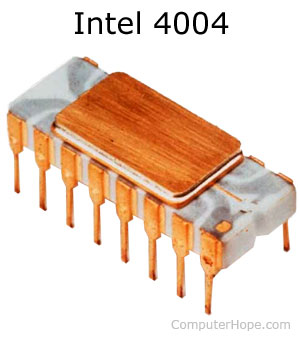Alternately referred to as a processor, central processor, or microprocessor, the CPU (pronounced sea-pea-you) is the central processing unit of the computer. A computer’s CPU handles all instructions it receives from hardware and software running on the computer. As an example, the CPU processed the instructions to use a web browser to open and display this web page on your computer.
The CPU is often referred to as the brain of the computer. However, it is more appropriate to refer to software as the brain and the CPU as a very efficient calculator. A CPU is really good with numbers, but if it wasn’t for the software it wouldn’t know how to do anything else.
Note
Many new computer users may improperly call their computer and sometimes monitor the CPU. When referring to your computer or monitor, it’s proper to refer to them as either the “computer” or “monitor” and not a CPU. The CPU is a chip inside the computer.
CPU overview
The picture below is an example of what the bottom and top of an AMD RYZEN processor may look like. The processor is placed and secured into a compatible CPU socket found on the motherboard. Processors produce heat, so they are covered with a heat sink to keep them cool and running smoothly. To help transfer the heat between the CPU and the heat sink
As seen in the picture above, the CPU chip is usually square with one notched corner to help make sure it’s properly inserted into the CPU socket. On the bottom of the chip are hundreds of connector pins that correspond to the socket holes. Today, most CPUs resemble the picture shown above. However, Intel and AMD have also experimented with slot processors. They were much larger and slid into a slot on the motherboard. Also, over the years, there were several types of sockets on motherboards. Each socket only supports specific types of processors and each has its own pin layout.
What does the CPU do?
The CPU’s main function is to take input from a peripheral (keyboard, mouse, printer, etc) or computer program, and interpret what it needs. The CPU then either outputs information to your monitor or performs the peripheral’s requested task.
CPU history
The CPU was first invented and developed at Intel with the help of Ted Hoff and others in the early 1970s. The first processor released by Intel was the 4004 processor, shown in the picture.
Components of the CPU
- In the CPU, there are two primary components.
- ALU (arithmetic logic unit) – performs mathematical, logical, and decision operations.
- CU (control unit) – directs all the processors operations.

- Over the history of computer processors, the speed (clock speed) and capabilities of the processor have dramatically improved. For example, the first microprocessor was the Intel 4004 that was released on November 15, 1971, and had 2,300 transistors and performed 60,000 operations per second. The Intel Pentium processor has 3,300,000 transistors and performs around 188,000,000 instructions per second.
Types of CPUs
In the past, computer processors used numbers to identify the processor and help identify faster processors. For example, the Intel 80486 (486) processor is faster than the 80386 (386) processor. After the introduction of the Intel Pentium processor (which would technically be the 80586), all computer processors started using names like Athlon, Duron, Pentium, and Celeron.
Today, in addition to the different names of computer processors, there are different architectures (32-bit and 64-bit), speeds, and capabilities. Below is a list of the more common types of CPUs for home or business computers.
Note
There are multiple versions for some of these CPU types.
AMD processors
| K6-2 K6-III Athlon Duron Athlon XP | Sempron Athlon 64 Mobile Athlon 64 Athlon XP-M Athlon 64 FX | Turion 64 Athlon 64 X2 Turion 64 X2 Phenom FX Phenom X4 | Phenom X3 Athlon 6-series Athlon 4-series Athlon X2 Phenom II | Athlon II E2 series A4 series A6 series A8 series A10 series |
Intel processors
| 4004 8080 8086 8087 8088 80286 (286) 80386 (386) 80486 (486) | Pentium Pentium w/ MMX Pentium Pro Pentium II Celeron Pentium III Pentium M Celeron M | Pentium 4 Mobile Pentium 4-M Pentium D | Pentium Extreme Edition Core Duo Core 2 Duo | Core i3 Core i5 Core i7 Core i |
The AMD Opteron series and Intel Itanium and Xeon series are CPUs used in servers and high-end workstation computers.
Some mobile devices, like smartphones and tablets, use ARM CPUs. These CPUs are smaller in size, require less power, and generate less heat.
